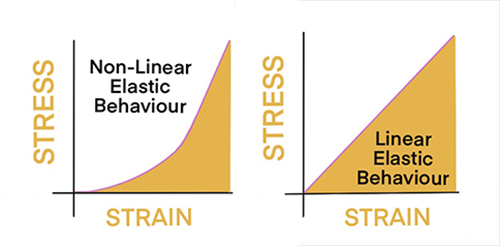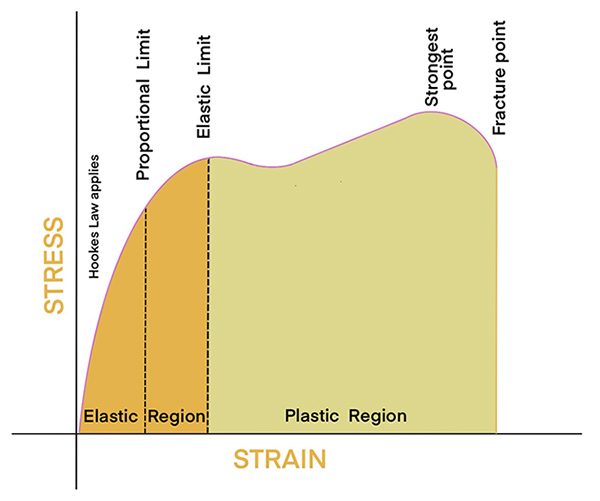Elasticity in construction
Elasticity describes the degree to which a material returns to its original shape after an external force or load has caused it to deform. All materials to some degree show elastic characteristics, some more so than others. This behaviour is a crucial characteristic of building materials without which they would suffer continuous deformation under load and ultimately collapse.
Linear elasticity occurs when the deformation in a material is proportional to the load applied, on a graph of stress and strain the line is straight. So, if a person weighing 50kg causes a diving board to deflect by 300mm, and another person weighing 100kg causes an identical board to deflect by 600mm, the diving board is exhibiting linear deflection. Most structural materials are, within limits, linearly elastic and are used within their linearly elastic range. Hooke's law of elasticity (named after the English scientist Robert Hooke in 1660) states that, for relatively small deformations of an object, the displacement or size of the deformation is directly proportional to the deforming force or load ie it is linear.
The point where the elasticity of a material is increasingly less linear and becomes non-linear is call the proportional limit. Non-linear elasticity occurs when the deformation in a material is not always proportional to the load applied, the behaviour changes as the load varies. On a graph of stress and strain the line representing the behaviour of the material curves.
The degree of elasticity will usually depend on the individual structure of a material at a microscopic level. In polymers and rubbers elasticity is created by stretching polymer chains under an applied force, whilst in metals elasticity results from a resizing and reshaping of crystalline cells of the materials structure (lattice).
Elastic materials have a limit which is the maximum stress per unit area it can withstand before being permanently deformed, this is called the elastic limit. After this point the material behaviour is plastic (ie it doesn't return to its original form and is permanently deformed).
[edit] Related articles on Designing Buildings
- Concept structural design.
- Detailed design.
- Elastic limit.
- Elements of structure in buildings.
- Moment.
- Plasticity.
- Stiffness.
- Structural engineer.
- Structural principles.
- Structural systems for offices.
- Structural vibration.
- Structures at the end of their design life.
- The development of structural membranes.
- Types of structural load.
- Vibrations.
Featured articles and news
Infrastructure that connect the physical and digital domains.
Harnessing robotics and AI in challenging environments
The key to nuclear decommissioning and fusion engineering.
BSRIA announces Lisa Ashworth as new CEO
Tasked with furthering BSRIA’s impressive growth ambitions.
Public buildings get half a million energy efficiency boost
£557 million to switch to cleaner heating and save on energy.
CIOB launches pre-election manifesto
Outlining potential future policies for the next government.
Grenfell Tower Inquiry announcement
Phase 2 hearings come to a close and the final report due in September.
Progress from Parts L, F and O: A whitepaper, one year on.
A replicated study to understand the opinion of practitioners.
ECA announces new president 2024
Electrical engineer and business leader Stuart Smith.
A distinct type of countryside that should be celebrated.
Should Part O be extended to existing buildings?
EAC brands heatwave adaptation a missed opportunity.
Definition of Statutory in workplace and facilities management
Established by IWFM, BESA, CIBSE and BSRIA.
Tackling the transition from traditional heating systems
59% lack the necessary information and confidence to switch.
The general election and the construction industry
As PM, Rishi Sunak announces July 4 date for an election.
Eco apprenticeships continue help grow green workforce
A year after being recognised at the King's coronation.
Permitted development rights for agricultural buildings
The changes coming into effect as of May 21, 2024.
























Comments
[edit] To make a comment about this article, or to suggest changes, click 'Add a comment' above. Separate your comments from any existing comments by inserting a horizontal line.